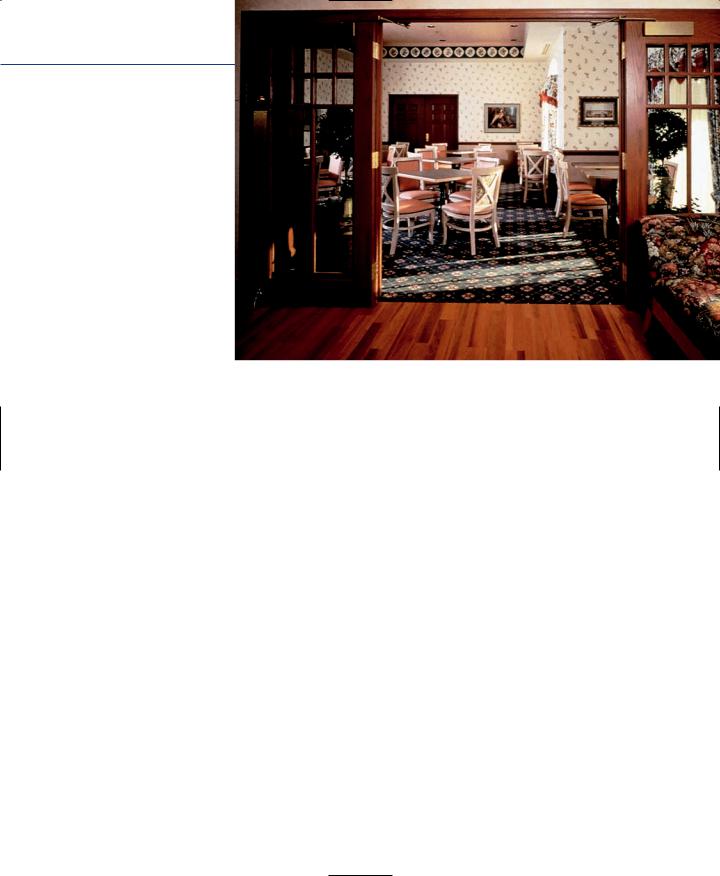
- •CONTENTS
- •PREFACE
- •Content—Benefits for Students
- •Content—Benefits for Instructors
- •Features of the Book for Students and Instructors
- •Supplementary Materials
- •Acknowledgments
- •What Is Hospitality Management?
- •The Manager’s Role in the Hospitality Industry
- •Why Study in a Hospitality Management Program?
- •Planning a Career
- •Employment as an Important Part of Your Education
- •Getting a Job
- •Employment at Graduation
- •The Outlook for Hospitality
- •Summary
- •Managing Change
- •Demand
- •Supply
- •Workforce Diversity
- •The Impact of Labor Scarcity
- •Summary
- •The Varied Field of Food Service
- •The Restaurant Business
- •The Dining Market and the Eating Market
- •Contemporary Popular-Priced Restaurants
- •Restaurants as Part of a Larger Business
- •Summary
- •Restaurant Operations
- •Making a Profit in Food Service Operations
- •Life in the Restaurant Business
- •Summary
- •Chain Restaurant Systems
- •Independent Restaurants
- •Franchised Restaurants
- •Summary
- •Competitive Conditions in Food Service
- •The Marketing Mix
- •Competition with Other Industries
- •Summary
- •Self-Operated Facilities
- •Managed-Services Companies
- •Business and Industry Food Service
- •College and University Food Service
- •Health Care Food Service
- •School and Community Food Service
- •Other Segments
- •Vending
- •Summary
- •Consumer Concerns
- •Food Service and the Environment
- •Technology
- •Summary
- •The Evolution of Lodging
- •Classifications of Hotel Properties
- •Types of Travelers
- •Anticipating Guest Needs in Providing Hospitality Service
- •Service, Service, Service
- •Summary
- •Major Functional Departments
- •The Rooms Side of the House
- •Hotel Food and Beverage Operations
- •Staff and Support Departments
- •Income and Expense Patterns and Control
- •Entry Ports and Careers
- •Summary
- •The Economics of the Hotel Business
- •Dimensions of the Hotel Investment Decision
- •Summary
- •The Conditions of Competition
- •The Marketing Mix in Lodging
- •Product in a Segmented Market
- •Price and Pricing Tactics
- •Place—and Places
- •Promotion: Marketing Communication
- •Summary
- •The Importance of Tourism
- •Travel Trends
- •The Economic Significance of Tourism
- •The United States as an International Tourist Attraction
- •Businesses Serving the Traveler
- •Noneconomic Effects of Tourism
- •Summary
- •Motives and Destinations
- •Mass-Market Tourism
- •Planned Play Environments
- •Casinos and Gaming
- •Urban Entertainment Centers
- •Temporary Attractions: Fairs and Festivals
- •Natural Environments
- •On a Lighter Note. . .
- •Summary
- •Management and Supervision
- •The Economizing Society
- •The Managerial Revolution
- •Management: A Dynamic Force in a Changing Industry
- •What Is Management?
- •Summary
- •Why Study Planning?
- •Planning in Organizations
- •Goal Setting
- •Planning in Operations
- •The Individual Worker as Planner
- •Long-Range Planning Tools
- •Summary
- •Authority: The Cement of Organizations
- •Departmentalization
- •Line and Staff
- •Issues in Organizing
- •Summary
- •Issues in Human-Resources Management
- •Fitting People to Jobs
- •Recruiting
- •Selection and Employment
- •Training
- •Retaining Employees
- •Staff Planning
- •Summary
- •The Importance of Control
- •Control and the “Cybernetic Loop”
- •Tools for Control
- •Summary
- •Leadership as Viewed by Social Scientists
- •Why People Follow
- •Leadership Theories
- •Communication
- •The Elements of Leading and Directing
- •Developing Your Own Leadership Style
- •Summary
- •A Study of Service
- •Rendering Personal Service
- •Managing the Service Transaction
- •How Companies Organize for Service
- •Summary
- •INDEX

480Chapter 14 Destinations: Tourism Generators
international visitors. They also handle problems that may arise at the tables. Finally, high rollers are assigned their own hosts when they are in the casino.
The floor person supervises between two and five dealers, depending on the game, and never more than four games. He or she is also responsible for closely watching repeat customers to estimate their average bet, a figure that is crucial to the casino’s marketing intelligence.
Slot machine areas are staffed by change people working under a supervisor. Change people and supervisors also offer recognition and personal contact for frequent visitors and slot high rollers.
Comps above a certain dollar level are generally approved by the casino’s senior management. Comp services for a junket group are approved by the casino’s marketing staff. Junkets are similar to tours that might be sold by a travel agent, except that the sights are generally the casino and its hotel environment, and there may be no charge for any of the services because of the expectation of casino play by the visitor. Junkets are put together by the casino or, more commonly, by junket brokers in distant cities.
Dealers need to be alert to players’ attempts at cheating, and they themselves are constantly scrutinized by supervisors and security personnel because of the temptation of dishonesty where so much cash is changing hands. The security systems in casinos are incredibly sophisticated and unlike anything in other segments of the hospitality industry. After tours of casinos, students inevitably comment on the security before anything else.
Working in casinos is very challenging. It requires a quick mind and an ability to work with people who are under considerable pressure. Players sometimes become abusive and unreasonable, and whenever possible, staff are expected to avoid a difficult scene, which may permanently alienate a player and his or her friends. Not surprisingly, the higher the roller, the greater the patience that may be expected of the staff. As is true with other segments of the hospitality industry, the casino industry is not for everyone. However, for those who like the excitement and the challenge, the segment provides great opportunities.
Urban Entertainment Centers
When traveling for recreational purposes, people do not just limit their visits to theme parks and casinos. There are many other types of environments that people are drawn to when vacationing. The term “urban entertainment centers” means just that—destinations located in cities (or even the cities themselves) that offer a variety of tourist-related activities. Urban entertainment centers vary

Urban Entertainment Centers |
481 |
widely. Some are designed on a smaller scale as a draw for local traffic and an enhancement to the local environment. Others are on a scale nearly as grand as those we considered in regard to theme parks, and there are many that fall between these two extremes.
Sports stadiums, one type of urban entertainment center, have been with us since the time of Rome’s Colosseum, but a relatively recent variety of such centers is the covered superdome (and increasingly with retractable roofs), such as those in Houston and Toronto. These types of stadiums have only been around since the 1960s. Domed stadiums tend to be multipurpose (or used for more than just one sport). These facilities (particularly the covered stadiums) host not only sports events but various types of entertainers, rock concerts, and circuses, and may also double as a convention center of sorts, such as the Superdome in New Orleans.
Turning our attention to baseball, a more recent development in stadium design has been to re-create the stadiums of old, as has been done at U.S. Cellular Field, formerly Comisky Park (Chicago), Jacobs Field (Cleveland), the Ballpark at Arlington (Texas), and Camden Yards (Baltimore). Further, after decades of relocating sports teams to the suburbs, teams are returning to the cities they once left. These stadiums (along with their teams, of course) have been given credit for drawing baseball fans back to the games as well as building all-important foot traffic in downtown areas. Sporting events do not just attract locals, however. They can be a major tourist attraction. Some fans/tourists take this to the extreme and go on extended trips during which they attend as many games as time will allow. Such travels have been chronicled in a number of recent books, such as Bruce Adams and Margaret Engel’s Baseball Vacations (Fodor’s, 2002). Spring training is also a major tourist attraction. Major League baseball teams train in February and March of each year in Arizona (referred to as the “Cactus League”) and Florida (referred to as the “Grapefruit League”). The Wall Street Journal estimates that the visitor spending on attending spring training games contribute $600 million to local communities in Arizona and Florida. Stadiums used for spring training games tend to be much smaller, and as a result, fans are able to be much closer to the action.
A close relative to “sports centers” are downtown convention centers, which allow for a mixture of business and pleasure. The visitors to a convention or trade show are on business. However, many of these gatherings are more social than professional, and even the most business-oriented meetings are, in large part, devoted to having a good time. Conventions bring major influxes of people and spending. Chicago, for instance, attracted over 7 million delegates who were attending various conventions, trade shows, and corporate meetings in 2006. Case History 14.2 examines one of the better-known hospitality industry trade shows.

CASE HISTORY 14.2
The National Restaurant Association Restaurant Show
The annual National Restaurant Association (www.restaurant.org) Restaurant Show, held in Chicago, celebrated its eighty-seventh anniversary in 2006. It is the food service industry’s largest gathering of people, exhibitors, and products/supplies. In order to appreciate the sheer magnitude of the show, consider the following:
■Attracts over 75,000 attendees
■Offers almost 2000 exhibits, which include anything and everything having to do with the restaurant/food service industry
■Shows the latest products and services available to the industry
■Covers 1.3 million square feet of exhibit space
■Offers culinary competitions, speakers, and activities for attendees, including the “Salute to Excellence,” to which select hospitality students are invited1
The show should be of interest to hospitality students for a variety of reasons: It represents a “destination” for people either in or affiliated with the restaurant industry; it is a good example of an enormous convention/trade show, as discussed in this chapter; and it is a major industry event that every hospitality student should attend at least once. About 60 hospitality programs were represented at the 2006 show. Each of these programs managed a booth on the show floor, where they were able to promote their schools. In most cases, the booths were staffed by both faculty and students of the program. Those who go each year already know what a valuable learning experience the show provides. Additional information about the show is available from the NRA office.
1. NRA Exhibit Guide and Program, 2006.
Convention, trade show, and sports centers were once largely the preserve of great metropolitan centers such as New York, with its Jacob Javits Convention Center, and Chicago, with McCormick Place. Increasingly, however, cities such as Seattle and San Jose, California, large but of second rank in size, have developed urban entertainment centers as a means of challenging established travel patterns and increasing the travel business in their markets. It should be noted that many cities are currently in the midst of expansion projects that will allow them to compete more effectively with New York, Las Vegas, and Chicago.
Although medium-sized cities cannot bid in the national convention market for the very largest conventions, they often can attract smaller national meetings and
482

Urban Entertainment Centers |
483 |
regional conferences. Many cities successfully sell bond issues to build civic meeting centers that improve a community’s ability to compete for its share of the travel market. That travel market, more and more city leaders are learning, means higher sales for local businesses, increased employment, and greater tax revenues.
Whether the results of these civic efforts always justify such an investment is subject to debate. In any case, though, somebody must operate these centers, and the skills involved (dealing with various travelers, providing food service, and managing housekeeping and building operations, to name only a few) clearly fall within the hospitality management graduate’s domain. The significance of this new area of hospitality management may be measured by the fact that ARAMARK has a special division to manage conference centers.
Increasingly, urban planners are including in their developments plazas designed to accommodate amusements, dining, and other leisure activities. One is also likely to find fine arts, gardens, and other visually appealing items adorning the area. The prototype of this kind of plaza is Rockefeller Center, in the heart of New York City. Rockefeller Center takes up all of 11 acres of prime real estate, which represents a combination of leisure/tourist and business activities. Among other things, it has fine shops, restaurants (including the world-famous Rainbow Room), and tourist attractions, such as tours of NBC studios. The 6,000-seat Radio City Music Hall is also located in the complex. It even has an ice-skating rink in winter, and it hosts horse shows, karate demonstrations, and model airplane contests in milder seasons.
Chicago is another city known for its architecture and public spaces. Some of the developments in that city include the First National Plaza, in front of the First Chicago Building, which is a model for plazas to come. A computer controls the fountain, so that visitors won’t get splashed on windy days. From May to October, the plaza features free noontime entertainment, late-afternoon concerts, and an outdoor café. It also has, year round, a restaurant, a bar, a legitimate theater, and retail shops.
City waterfront redevelopment projects, too, have become centers that attract visitors and enrich the lives of local people. Both Boston’s and Baltimore’s efforts have received a lot of attention over the last couple of decades; they literally changed the image and demeanor of those cities. Other cities, albeit with different types of waterfronts, include New Orleans and San Antonio. These cities have done an effective job of using waterways as a central focus of their cities.
Restoration and revitalization of aging sections of a city require the involvement of hospitality industry operations. Dallas Alley (in Dallas, Texas) was built in what was a half-forgotten place that housed freight cars, warehouses, and factories. In an old Sunshine Biscuit factory and an adjoining building that was once a Coca-Cola bottling plant, a group of private investors built Dallas Alley, an aggregation of nine nightclubs. The center is located near a $25 million festival marketplace housed in a former cracker

484Chapter 14 Destinations: Tourism Generators
and candy factory. Dallas Alley alone attracts over a million visitors annually. Similarly, the old Jax Brewery in New Orleans was converted and now houses retail shops and restaurants.
SHOPPING CENTERS
Shopping centers are usually thought of as catering principally to local shoppers. Even so, such centers can be more than a little ambitious. The St. Louis Centre suggests the scale of a large, locally centered mall and the often close relationship of such centers to the hospitality industry. The Centre was begun as an urban renewal project in 1972 and was completed 13 years later at a total cost of $17.5 million. Comprising a two-block stretch of downtown St. Louis, the Centre serves about 10 million people each year, comprising a mix of locals, conventioneers, and tourists. The Centre has a mix of retail shops, sit-down restaurants, and a food court. Despite the fact that it has had financial problems in recent years and has subpar retail occupancy, it is still considered a key project in enhancing the downtown area. Another landmark is Water Tower Place, prominently located on North Michigan Avenue in Chicago. The mall is a marvel to look at and a shopper’s destination—it has over 100 stores, many food service operations, and visual spectacles. The mall draws over 20 million shoppers each year. It recently underwent a $17 million renovation. Other cities that have established similar retail attractions include New Orleans and Boston, among many others. As shopping continues to grow in popularity (some have labeled it as the new religion), malls such as the ones described above will only proliferate and will continue to anchor both urban and suburban development. The fact that shopping has become the most favored tourist activity will only fuel this growth (40 percent of shoppers at Water Tower Place are tourists). Retail shopping centers only continue to get larger, as well, as illustrated in the examples given below.
Finally, let’s look briefly at four exceptionally large shopping centers, one in western Canada, one in Minnesota, and two in China. In the case of the West Edmonton Mall (in Canada), the aim from the very beginning was to attract tourists, as well as local residents to the center. This was necessary because Edmonton, Alberta, a city of less than 1 million, could not support a mall of this scale by itself. Such facilities have been termed megamalls.
The scale quite literally boggles the mind. Consider its total indoor area of 5.3 million square feet, equivalent to 28 city blocks. It is a combination megamall/amusement park/food court/hotel/recreation center/museum/casino. In fact, it combines all of the elements already discussed in this chapter. Malls are also supposed to have stores, and it has 800 of them, along with over 100 restaurants, miniature golf, an aquarium, movie

Many of the 40 million travelers who visit the Mall of America each year choose to extend their stay in one of the many hotels available. (Courtesy of Carlson Hotels Worldwide.)
theaters, and several major attractions unto themselves. The ceiling peaks at 16 stories with a mile-long, two-level main concourse. The interior plantings include $3 million worth of tropical plants, which includes a grove of 50-foot palm trees. The mall houses an amusement park and a water park with a 5-acre pool where you can surf on 6-foot waves, water-ski, ride the rapids, and get a suntan, even when the outside temperature is well below zero. The sights include a dolphin show, a Spanish galleon, an 18-hole miniature golf course, a 50,000-gallon aquarium, and four submarines. The 33-foot-long computer-controlled subs will seat 24 people. The mall is dedicated to the idea that shopping is more than just a utilitarian chore and can be an opportunity for fun.
About a third of the visitors to the mall are from Edmonton and its trading area. Nearly a fifth are from Alberta outside the 60-mile trading area. The other half comes from the rest of Canada and the United States. Half of these Canadian visitors and 75 percent of the Americans come specifically to visit the West Edmonton Mall. Visitors from the United States average a four-day stay. Visitors, interestingly enough, spend as much or more money outside the mall as they do inside.
In Bloomington, Minnesota, just outside Minneapolis, is another megamall only slightly smaller than the West Edmonton Mall. The Mall of America covers 4.2 million square feet (about 78 acres). An indoor 7-acre theme park, Camp Snoopy, at the heart of the mall, offers 50 rides, shows, and other attractions. The mall also includes over 500 retail outlets as well as an 18-hole miniature golf course and over 50 restaurants, nightclubs and bars, movie theaters, and live entertainment. To top it off, there is a university, a health care clinic, and the “Chapel of Love” for those maritally inclined.
485

486Chapter 14 Destinations: Tourism Generators
Thirteen thousand people are employed at the Mall of America. The mall drew 35 million visitors during its first year, and it continues to draw between 35 and 40 million people each year. The mall even has its own newspaper to keep its faithful properly informed of current and upcoming events.9 Although a description of the mall cannot begin to do it justice, readers might want to visit its Web site and take the virtual tour (www.mallofamerica.com).
For a long time, the two malls just discussed claimed supremacy in terms of size and traffic. This has changed, though, as China and other Asian countries have begun to build malls on a grand scale. It is estimated that eight of the ten largest malls in the world are now located in Asia, and most of these are located in China. The South China Mall (in Dongguan) and the Golden Resources Mall (in Beijing) are two of the largest. At a size that is 50 percent larger than the Mall of America, Golden Recources is advertised as “the mall that will change your life.” The growing economy of China is driving the building (and patronage) of such malls. The malls in China have more diversity of offerings than typical North American malls. More malls are currently under development, including some that are on an even larger scale.10
ZOOS, SANCTUARIES, AND AQUARIUMS
Zoos and aquariums can be major tourism generators. For instance, each year roughly 5 million people visit the San Diego Zoo. The zoo also operates an 1,800-acre wildlife preserve 30 miles north of San Diego. The zoo and preserve, like so many other tourist destinations, have a substantial educational mission. The preserve, for instance, is visited by 40,000 elementaryand secondary-school children each year. Other well-known zoos in the United States include the Bronx Zoo and the Washington Zoo. Aquariums, too, are becoming ever more popular. Fine aquariums exist in Baltimore, Boston, New Orleans, Chicago, and Vancouver, as well as some smaller cities throughout North America. Well-known international zoos include the London Zoo and the Antwerp Zoo in Belgium. Unique sanctuaries exist all over the world as well. In Central America, the Community Baboon Sanctuary in Belize helps to protect the locally known baboons (or Black Howler Monkeys). The Sanctuary has received funding from the World Wildlife Fund and is a major attraction for visitors to that country. In Australia, the Currumbin Wildlife Sanctuary (outside of Brisbane) allows visitors to interact with kangaroos, wallabies, and koalas. Revenues help support the local wildlife hospital.
As with other attractions discussed earlier in the chapter, zoos, sanctuaries, and aquariums must provide food service to their visitors. Also, like other attractions, the number of visitors to these destinations expands when school is out. As a result, these operations can offer summer employment opportunities to students, with a decent chance at getting into a supervisory position.
